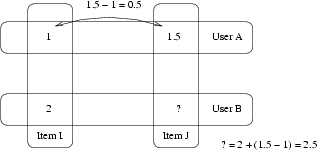SlopeOne推薦演算法實現(C++)
阿新 • • 發佈:2019-01-08
SlopeOne演算法是一個非常簡單的協同過濾演算法,主要思想如下:如果使用者u對物品j打過分,現在要對物品i打分,那麼只需要計算出在同時對物品i和j打分的這種人中,他們的分數之差平均是多少,那麼我們就可以根據這個分數之差來計算使用者u對物品i的打分了,當然,這樣的物品j也有很多個,那有的物品和j共同打分的人少,有的物品和j共同打分的人多,那麼顯而易見,共同打分多的那個物品在評分時所佔的比重應該大一些。
如上就是簡單的SlopeOne演算法的主要思想,用維基百科上的一張圖來表示(一看就懂):
途中使用者B要對物品J進行評分,那麼這時候發現物品i被使用者B打為2分,而同時發現使用者A同時評價了物品i和物品j,且物品i比物品j少了0.5分,那麼由此看來,使用者B給物品j打得分應該就是比給物品i打的分高0.5分,故是2.5分。
由於思想是如此簡單,故我們就來實踐一把,當然這裡就是最最樸素的實現,只是為了檢測下演算法效果如何。。。資料集還是如上篇部落格一樣,用的是movielens裡面的小資料集,其中有1000使用者對2000物品的評分,80%用來訓練,20%用來測試。
具體程式碼如下:
#include <iostream> #include <string> #include <fstream> #include <math.h> using namespace std; const int USERMAX = 1000; const int ITEMMAX = 2000; double rating[USERMAX][ITEMMAX]; int I[USERMAX][ITEMMAX];//indicate if the item is rated double mean; double predict(int u, int l) { double total = 0; double totalCnt = 0; for (int i = 0; i < ITEMMAX; i++) { if (l != i&&I[u][i]) { double dev = 0; int cnt = 0; for (int j = 0; j < USERMAX; j++) { if (I[j][l] && I[j][i]) { dev += rating[j][i]-rating[j][l]; cnt++; } } if (cnt) { dev /= cnt; total += (rating[u][i] - dev)*cnt; totalCnt += cnt; } } } if (totalCnt == 0) return mean; return total / totalCnt; } double calMean() { double total = 0; int cnt = 0; for (int i = 0; i < USERMAX; i++) for (int j = 0; j < ITEMMAX; j++) { total += I[i][j] * rating[i][j]; cnt += I[i][j]; } return total / cnt; } void train() { //read rating matrix memset(rating, 0, sizeof(rating)); memset(I, 0, sizeof(I)); ifstream in("ua.base"); if (!in) { cout << "file not exist" << endl; exit(1); } int userId, itemId, rate; string timeStamp; while (in >> userId >> itemId >> rate >> timeStamp) { rating[userId][itemId] = rate; I[userId][itemId] = 1; } mean = calMean(); } void test() { ifstream in("ua.test"); if (!in) { cout << "file not exist" << endl; exit(1); } int userId, itemId, rate; string timeStamp; double total = 0; double cnt = 0; while (in >> userId >> itemId >> rate >> timeStamp) { double r = predict(userId, itemId); cout << "true: " << rate << " predict: " << r << endl; total += (r - rate)*(r - rate); cnt += 1; //cout << total << endl; } cout << "test rmse is " << pow(total / cnt, 0.5) << endl; } int main() { train(); test(); return 0; }
實驗結果如下:
在測試集上的rmse達到了0.96,而之前一篇部落格實現的svd通過複雜的梯度下降來求最優解也就0.95左右,故SlopeOne演算法是非常簡單有效的,維基百科裡說是最簡潔的協同過濾了,但是我個人覺得類似knn的協同過濾更加好懂啊(只不過在計算使用者相似度等方面麻煩了點)


